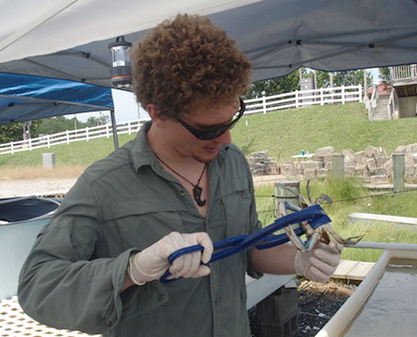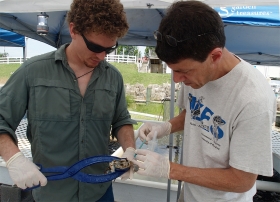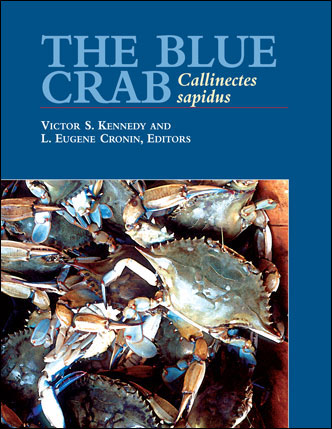Knauss legislative fellowships in Congress help build careers — and they're fun and educational. See our video and fact sheet for details.
Killing Them Softly: How a Virus Infected the Peeler Crab, and How One Researcher Found a Way to Hold it at Bay
All year long, hundreds of crab legs arrive in the mail at Baltimore’s Columbus Center, home of the Institute of Marine and Environmental Technology.
But Eric Schott and his fellow crab researchers aren’t planning an off-season Old Bay feast. These crab legs are samples, likely infected with a crab virus called CsRV1, that is killing the lucrative peeler crabs that watermen catch and put in shedding tanks to let them “shed” and then sell as soft-shell crabs. They are coming from Louisiana, Virginia, and places in Maryland, where Schott and several researchers have been taking blood samples from crabs to determine if they are sick, and if not, when they might become sick. It’s easier, Schott said, just to ship the leg, which contains enough information on the virus for the scientists to examine.
A soft crab can bring a waterman six times as much as a hard crab can, so watermen that operated shedding tanks had learned to live with mortalities of up to 25 percent in their tanks because they could still make money on the rest of their catch. But a a decade ago, when Schott made two important discoveries: that indeed a virus was infecting the crabs, and that watermen didn’t have to live with it anymore. Instead, they could manage it.
Working with colleagues in Virginia and Louisiana, Schott was able to offer practical advice to the owners of shedding tanks throughout the Chesapeake Bay so they could keep their lucrative catch from dying. Peeler pen operators take wild crabs from the bay and its tributaries as they’re ready to molt; a colored marking on their swimming fin indicates where in the process they are. The watermen place them in tanks according to their molting stage, so they won’t eat each other, and when the crab sheds its shell it becomes a culinary delicacy popular in sandwiches and main courses.
Schott’s solutions included taking water from estuarine waters high in oxygen, instead of from small tributaries or coves that can be more susceptible to low oxygen levels; and running the water through a biofilter, such as discarded oyster shells, to decrease the amount of ammonia and nitrates in the tanks holding the crabs.
But Schott, a geneticist with the University of Maryland Center for Environmental Science, still has questions about the mortality of crabs in the wild from the virus, as well as its transmission to other crabs, possibly passed through injuries or cannibalism. The virus attacks the crab’s immune system, which has no antibodies or immunological memory, but consists of cells that destroy invading bacteria. The virus kills the crabs slowly, making it hard to determine in the wild whether the death was from water-quality conditions, predation, or the infection.
Typically, peeler operations circulate water through a system of tanks to hold crabs until they molt; the effluent from that process is then discharged into the water. Schott wondered if there was a significant correlation between virus-infected wild crabs and their proximity to shedding operations. With funding from Sea Grant, he worked with the Smithsonian Environmental Research Center to investigate the question near large-scale shedding operations in Deal Island and Crisfield.
The researchers, who included Sea Grant Fellow Emily Flowers and field ecologists from SERC, found more instances of wild crab mortality next to the shedding tank effluent than two kilometers away, but many questions still remain.
“A question that is still hanging out there for us is that we have not been able to measure whether a crab that’s infected in the wild has a shorter life span than the one in captivity,” Schott said. “Though it stands to reason that infected crabs would die earlier, we have not yet shown that.”
In the shedding tank, it unquestionably does. Of the more than 100 crabs in a shedding system the team looked at one day this summer, 51 percent died before they molted. That was about twice what was typical. Of the dead ones, Schott said, 86 percent were infected with CsRV1. Schott and his colleagues, including graduate student Matt Spitznagel, are working on a paper detailing the results. These data suggest a high incidence of virus infection can be found in soft shell crabs and mortalities may become unacceptably high for the industry.
 |
|
Matt Spitznagel, a graduate student at IMET in Baltimore, focuses on a crab. Photograph, Rona Kobell |
Schott has been working with partners at Louisiana State University and Virginia Institute of Marine Science and watermen in the community to organize workshops and communicate the virus information so that they can tend to possible issues in shedding operations, including the way their water circulates, where they get it from, and how they dispose of dead crabs (hint: not back in the waters, where they may infect others.) One crabber, Coveside Crabs’ Richard Young, decided to use more oxygenated water from the Bay, which he has to drive a significant distance to get, rather than the water from his cove. It’s significantly lowered the mortality, said his wife, Lee Carrion, who runs the soft crab operation. and was one of the first crabbers to work with Schott.
The group held meetings in Galesville, MD and Gloucester, VA last year, and is planning one in Talbot County this winter. If the operators can decrease diseases in their tanks, it may translate to less disease in the wild population, too. Schott believes the disease is acquired in the wild, but the close proximity in the tanks allows it to spread faster, just as a cold virus can spread through a subway car or crowded airplane cabin. He is also looking at whether cannibalism is a factor, if the crabs become infected when they consume each other. The virus is not toxic to humans.
“If we can understand how the virus impacts natural mortality, there may be ways to predict the crab harvest better,” Schott said. “In ecology, diseases are known to be drivers, but we haven’t had the tools to measure these diseases until recently.”
Photo, top: Eric Schott (right) and his graduate student, Matt Spitznagel, take a blood sample from a crab at Phillips Wharf Environmental Center on Tilghman Island. Credit: Rona Kobell
See all posts from the On the Bay blog








